The thing about being first is that it usually puts a target on your back. For Street Fighter, despite setting the standard for an entire genre in 1987, and perfecting it in 1991, it meant that the franchise would almost immediately be against the ropes.
With its breakout followed the very next year by Midway’s splatter-fest Mortal Kombat, then by an onslaught of increasingly technologically advanced series like Virtua Fighter and Tekken, the OG combat king primarily had to lean on playing better than the competition to thrive.
And although being the best around can work for a while — even if the pros are in your corner — there will always be a new challenger lined up to take the title. This was the case during a lull in the aughts, but especially in the 2010s where (mortal) enemy MK got the upper hand with NetherRealm’s relaunched ninth installment, kicking off a trilogy of games (9, X, and 11) that would ultimately trounce Street Fighter V in terms of sales.
And deservedly so! How does one compete with a game that lets you use RoboCop against Rambo to pin his tonsils to his temples like a shish kebab at the press of a button?
But what if it didn’t have to be that way? What if Street Fighter could have all the hallmarks of a modern blockbuster? Cutting edge graphics. A robust single-player campaign. Heavy customization, reliable online play, and waves of new content with a healthy community through an ongoing live service? Mostly importantly, what if you could press that one button to righteously kick your buddy’s ass?
Street Fighter 6 does all of that and does it well.
Friendship over.
Captured on PS5
Developed by Capcom under game director Takayuki Nakayama and producer Shuhei Matsumoto — replacing franchise lead Yoshinoro Ono — Street Fighter 6 is a game of contrasts. Despite reviving a legacy brand, it also feels like a fresh start. Although it’s complex enough to land in esports stadiums, it’s by far the easiest for newcomers to pick up. And even though its creators have described it as having been inspired by the notion of, “What if we created Street Fighter II today?” it feels like an amalgamation of all the franchises best ideas woven together like video game Jeet Kune Do.
The first thing you’ll notice upon booting up Street Fighter 6 is its slick presentation. Street Fighter IV famously dragged the series out of the pixel art era with fully 3D models on a 2D plane, but it maintained a timeless look by leaning into a pseudo cel-shaded aesthetic defined by bold lines with paintbrush-like strokes.
Street Fighter 6 does something similar, but instead of going full ink wash, it plays up a graffiti accent that evokes the series roots as an “urban” brawler. As we learned when speaking with its creative team, one of the major sticking points for this entry was going full bore into the “street” part of the fighter. That translates to an urban setting for the menus and single-player campaign, a collection of hip-hop themed tracks for the soundtrack (including its main theme) and informs some of the new characters joining the roster.
It all feels a little on-the-nose, but not entirely out of place as the hip-hop overtones were famously a major part of Street Fighter III: 3rd Strike — one of the series’ most revered entries — and the graffiti aesthetic goes back as far as the very first game.
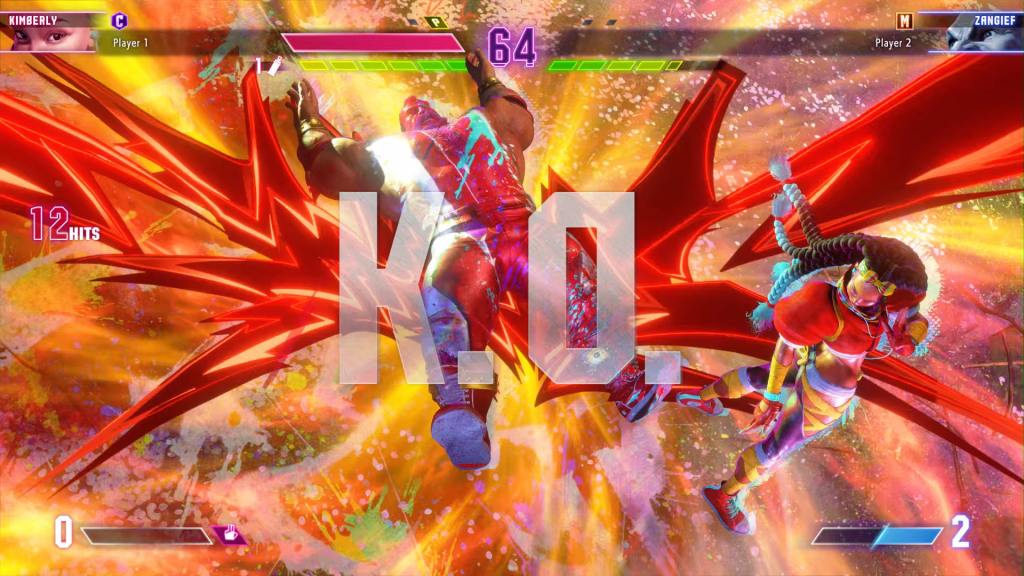
Graffiti art canvases come in all shapes and sizes.
Captured on PS5
In practice, the style is generally plucky and inviting, giving everything from the basic UI to the load screens that extra bit of life between the highs of battle. The heavy hip-hop soundtrack replaces what’s traditionally an eclectic, vaguely jazzy vibe that most Street Fighter games employ and brings a sense of bravado to each individual character, whose personal themes stray into several genres, but all feels equally big. There are earworms aplenty in the mix and you’ll likely be mindlessly humming a few of its tunes after just a couple matches.
Graphically, the game walks a fine line between grounded design with visual flourish. Running on Capcom’s proprietary RE Engine, the character models are chunky and weighty, despite still having a more “realistic” look than the previous two games, which leaned more cartoonish. With some major legacy character updates and a new generation of fighters (some of whom have ties to absent favorites), it’s easy to see the work that’s been done to balance the size and speed of each brawler while relishing their individuality.
That said, there is a persistent feeling that this could look better. Even when Street Fighter has elevated its sprite work (SFIII) or gone artsy (SFIV & V), it’s generally lagged the competition in terms of sheer visual spectacle. Part of the next fighting game resurgence, Street Fighter 6 is releasing just ahead of its next major rivals, Mortal Kombat 1 and Tekken 8, both of which have already been lauded for their staggering graphical fidelity.
It’s a shame because the game doesn’t look bad by any stretch. In fact, it looks incredible in motion in ways that no screenshot can do justice. It runs flawlessly at 60fps, feels tightly polished and responsive, and generally buttery smooth. And it’s dripping with personality.
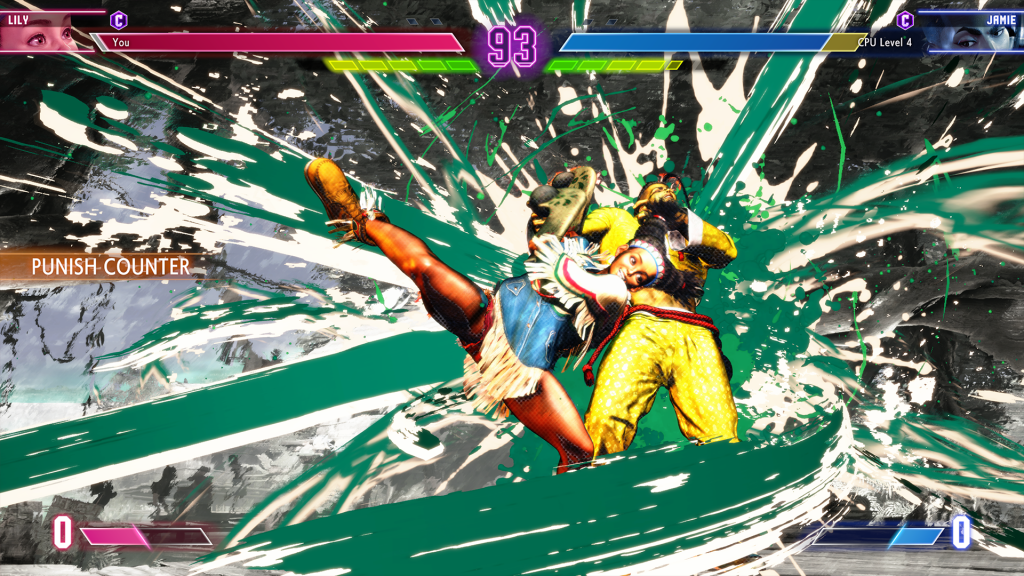
Never ugly, especially when it goes full Jackson Pollock.
Captured on PS5
But if you stop to look around you can easily see where the concessions were made. The backgrounds of levels are low poly, with NPCs clapping or cheering lifelessly during matches like they’re bound in a Westworld loop. There often seems to be a disconnect between the effort put into the character models versus what’s been done on the environments, which is disheartening because many of the series’ classics felt alive in that way.
But there’s an argument to be made that the background minutiae are merely a distraction, and what truly matters is the action taking place in the foreground. And that action is where Street Fighter 6 shines, and where the competitors with all their bells and whistles will have their work cut out for them.
Pound for pound, nothing plays as good as Street Fighter. Nothing.
There’s a reason its gameplay set the pace for everything else to follow, and even though its controls are manageable — if not second nature to coin-dropping arcade junkies from a bygone era — what really puts this iteration ahead are the ways in which it opens to people who have no idea what they’re doing.
From the onset after selecting any character, players are given three control schemes to choose from: Classic, Modern, and Dynamic. Classic plays, well, classically. It’s the raw Street Fighter experience, straight from the 1990s. Press back to block, up to jump, and break out directional quarter circles and specific inputs to execute the flashy parts.
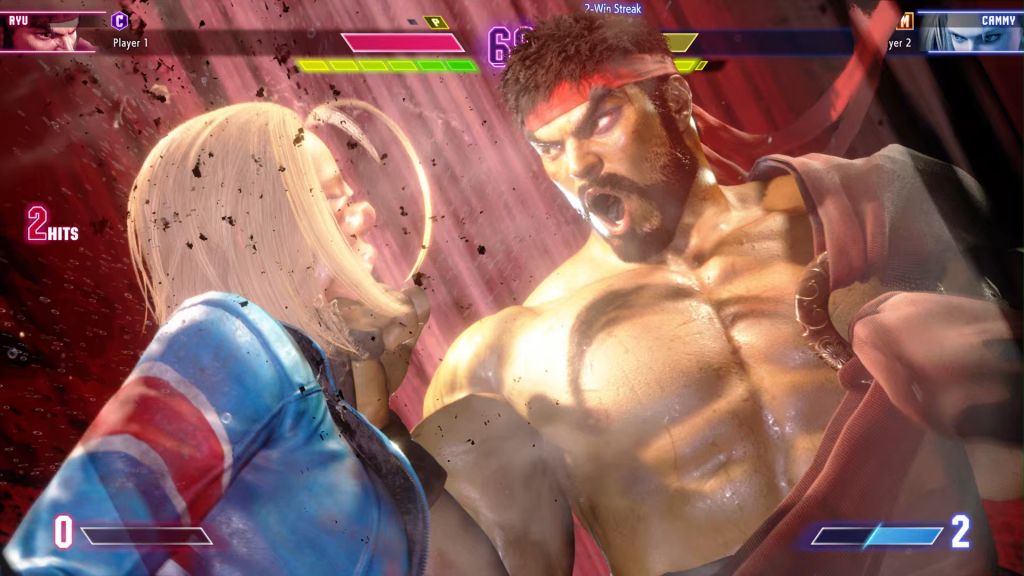
The flashy parts are when your opponent’s face turns to jelly.
Captured on PS5
For veterans or players looking for a challenge, this is the core experience, and it plays better than ever. Integrating a version of the parry system from Street Fighter III, conjoined with the new Drive Impact feature that allows players to strategically expend energy to eat a few hits and garner an advantage, there’s cascading levels of complexity here that’s clear enough to make anyone feel like they’re living their own Evo moment.
But the second two play styles are what make Street Fighter 6 feel like it can strike back into the zeitgeist. Modern controls streamline the input process to assign some of the more intensive commands to simplified button presses. Not great at timed execution of button combos? This mode will allow you to input less and do more, but in a way that never feels like training wheels.
Now Dynamic mode? It’s a set of training wheels, but that’s exactly what some people want. Even further simplified beyond Modern, it maps all of the character’s special moves to simple face buttons. Call it “one button Hadōken,” but what you can’t call it is cheating. Like any precisely balanced and deftly designed game, the devil is in the details, and even though these new modes kick open the door of accessibility and allow every kind of player to step up and enjoy the game, there is no substitute for practice at high-level play.
Rather than take anything away from the game’s street cred, it opens this avenue to everyone. Even more so than Mortal Kombat 11, which is easy to pick up but wildly inappropriate for kids, Dynamic mode in Street Fighter 6 levels the playing field in ways that have made games like Super Smash Bros. Ultimate a cross-generational juggernaut.
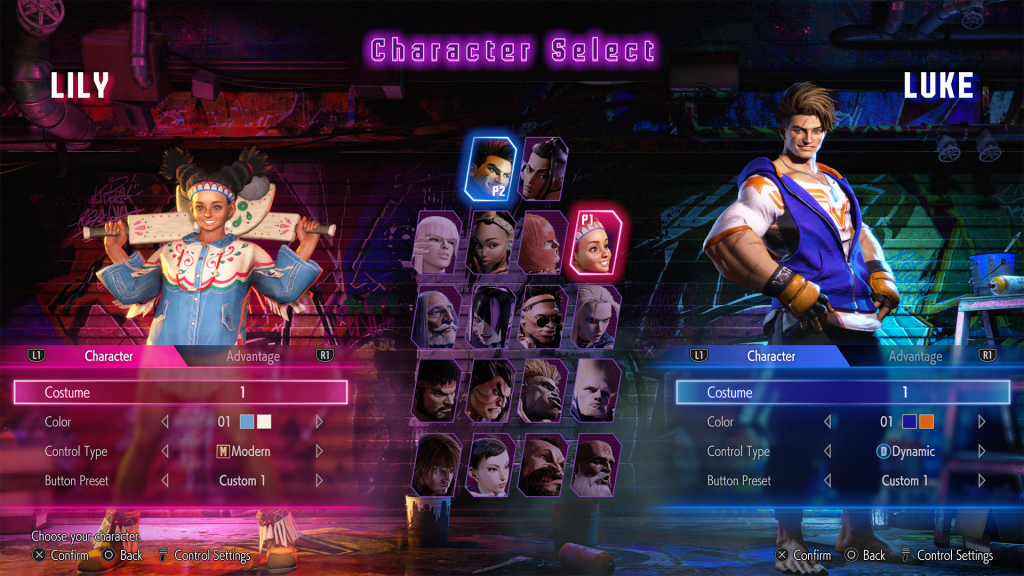
A diverse roster with accessibility options make this an absolute win.
Captured on PS5
During the review window, we set up a station at the Rolling Stone office with an open call for players and the impact of Modern and Dynamic modes were instantly recognizable. Players of all ages, with differing levels of experience or comfort with either a gamepad or fight stick — or even those generally uncomfortable with video games in general — were able to jump in and compete with ease. Being this approachable bodes well for bringing the franchise back into the limelight.
Another contributor to that accessibility is the roster. Part of Street Fighter’s DNA from the very beginning has been its global appeal and that begins on a character level. While never as overtly offensive as say, Punch-Out!, the early Street Fighter games did lean into some soft stereotyping when bringing instantly recognizable cultures to the screen. But historically, Capcom has tried to lean into the cultural identity of its creations in ways that highlight character, rather than caricature.
Take for instance baby faced addition, Lily. A member of the Thunderfoot tribe, she represents a fictional indigenous culture of Mexico, complete with tribal garb and a noticeable accent. But Lily soars with personality over than baggage, especially as a replacement for her more obviously stereotypical progenitor, Street Fighter II’s T. Hawk. It helps that Lily is also adorable and wickedly addictive to play.
Other newcomers include ninja-in-training Kimberly, who has quickly risen in the ranks during the open beta to become the game’s first queen of the meta, as well as the Bison-esque JP, balletic brawler Manon, gladiator-like Marisa, and the Jackie Chan-inspired drunken master, Jamie. Like the best Street Fighter characters, each brings something very specific to the table in terms of fighting style, while also accentuating a particular cultural flourish unique to the region they rep.
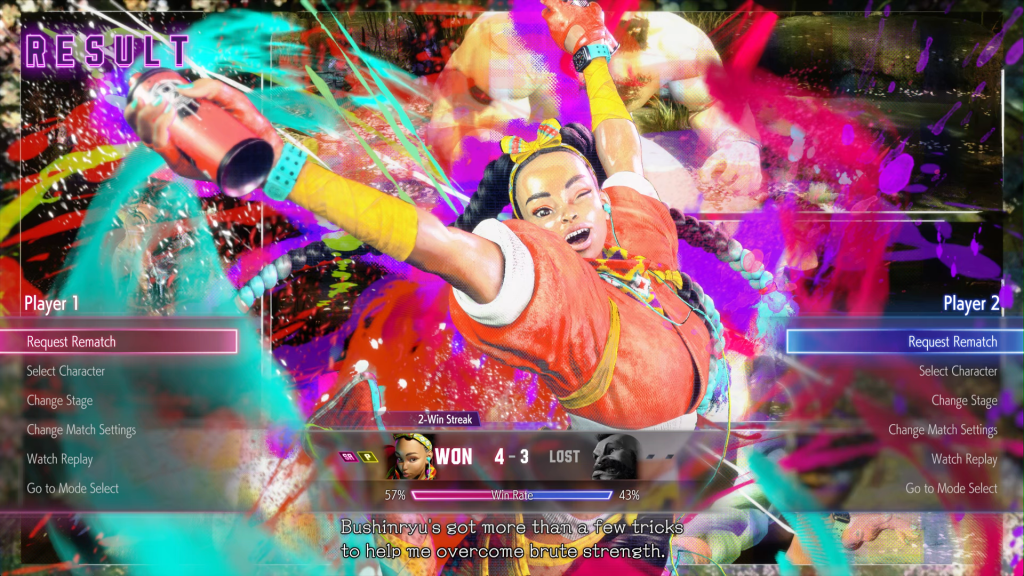
You’re going to see this victory screen online. A lot.
Captured on PS5
But the greatest leap forward for Street Fighter 6 isn’t just who can choose to be, but who you can create. For the first time in the series’ history there’s now a fully featured and lengthy single-player campaign to explore – complete with character creation. Yes, you can create your own fighters and the possibilities feel endless.
While some games opt to play it safe to retain immersion, Street Fighter 6’s character creation options are fucking gonzo. While representative of just about every body type there is, that also means you can make Popeye-armed monsters painted any manner of neon and take to the streets to beat down a city’s worth of opponents, peppered with legacy characters along the way.
A meaty campaign with reasonably detailed exploration elements, World Tour mode brings something entirely new and much needed to the franchise and gives players who may not want to play online or whose friends won’t budge something more meaningful to do than simply chase the high score in Arcade mode.
Alas, for all the props Capcom gets for making a quantum leap forward in effort here, there’s still a way to go before they catch up with the likes of Mortal Kombat. While MK’s story is ridiculous, it’s still a massive undertaking with intricately plotted and jaw-droppingly produced cinematics with top-tier motion capture performances. There’s nothing here that even approaches it, although World Tour does fit more in the mold of MK11’s Krypt.
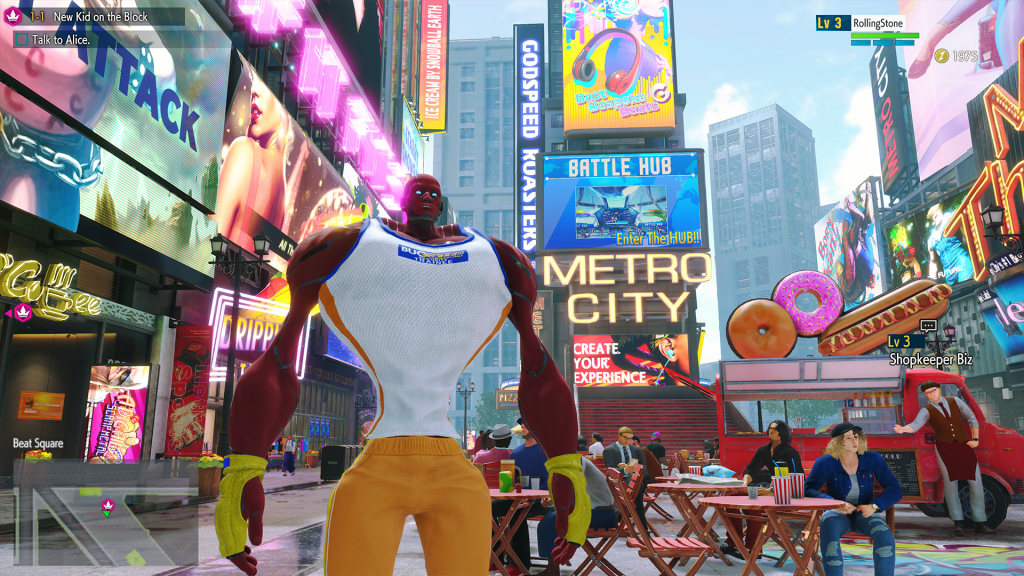
What hath God wrought?
Captured on PS5
It’s obvious that Street Fighter has never been about its story, and everything delivered here is still a massive improvement over what we’ve seen before, but we’re at a point in gaming when saddling an Arcade mode with a handful of illustrated slide shows simply won’t do. World Tour is a great start, but there’s room for more as this game evolves through live service.
And lastly, there’s Battle Hub, which is the crown jewel of what Street Fighter 6 hopes to offer. With an emphasis on its community, Street Fighter is playing into its greatest strength in this mode. Part game lobby, part metaverse (icky word, I know), it’s a space for players everywhere to walk out their homebrewed avatars to be seen. In the hub’s virtual space, players control their character to mingle and match up online for SF6 bouts as either contender or spectator, chat with likeminded folks, or do some shopping. You can even play a rotating assortment of retro games, just like at an old arcade.
And that’s really the beauty of not just this one mode, but the whole package. Every aspect feels painstakingly crafted and thoughtfully engineered to celebrate all the best parts of Street Fighter: its rich personality, pitch perfect controls, and dedicated community. With an open armed approach to accessibility, it’s earnestly hoping to expand that last part.
Never satisfied with being the underdog, Street Fighter is mounting a return and just like that, the champ is back. Now get in line.
Street Fighter 6 launches June 2 on PC, Xbox Series X|S, and PlayStation 4 & 5. This review reflects the PlayStation 5 version.
